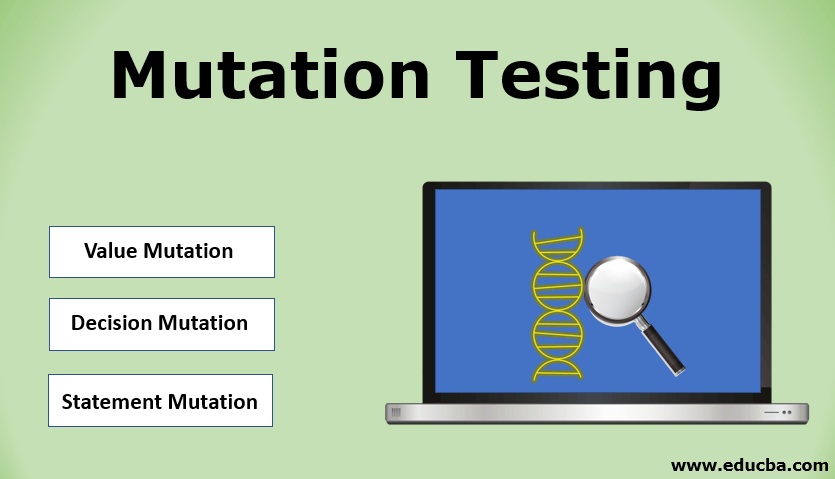Updated March 17, 2023

Introduction to Mutation Testing
As the word ‘mutate’ in general means the ‘change,’ so does the Mutation testing signifies. Mutation testing is the type of software testing performed by changing or mutating the piece of code to check/verify that the test cases are capable enough to find the errors/defects. It comes under the White Box testing and is basically done while performing the Unit tests of a particular module of an application. The changes done in the source/main code are made in a small amount so that it would not affect its overall objective. This is also known as the Fault Detection Technique, as it is done for the purpose of locating the weakness of test cases by creating a fault in the original code.
Before performing any testing, it is very important to understand the objective behind it. The main objective of Mutation testing is to find the effectiveness of the test cases developed, which should be capable enough to detect even the small change made in the code. It is done to find the issues in the testing suite and the test data that is being used while performing the testing of any software application. Multiple mutants or versions of the original code are created, and each one of them is tested against the original test cases. If the test case results remain the same as we’re in the original code, then both the code and test cases are checked again because either the code was not executed or the test suite is not capable enough to find the mutant code.
Types of Mutation Testing
There are basically 3 types of Mutation testing that are performed to create mutants of the original code:
1. Value Mutation
As the name indicates, in Value mutation, the value of constants, parameters passed in the methods, values used in loops are changed to create a mutant program. Either the large value is changed to a smaller one or vice versa. Basically, the values which are already defined in the program are changed to perform Value Mutation.
Original Code:
int a = 75636737;
int b = 3454;
int mult = a * b;
print(mult);Mutant Code:
int a = 75;
int b = 345466465;
int mult = a * b;
print(mult);2. Decision Mutation
In Decision Mutation, the logical and arithmetic operators used in the program are changed, which changes the overall decision-making in the program and its respective results. For example, a certain ‘if’ statement runs only when (a > b). In mutant code, this operator is changed to (a < b), which changes the code’s overall decision-making.
Original Code:
if (a>b || b>c)
{
print("yes");
}
else
{
print ("No");
}Mutant Code:
if (a<b || b<c)
{
print("yes");
}
else
{
print ("No");
}3. Statement Mutation
In Statement Mutation, changes are made in the full statements of code in order to create a mutant program. Changes in the statement can be deleting the whole statement, changing the order of statement in code, copy and paste the statements at some other location in code, repeating or duplicating the few statements in the original code.
Original Code:
if (a > b)
{
print("a is greater");
}
else
{
print("b is greater");
}Mutant Code:
if(a > b)
{
// removing the statement
}
else
{
print("b is greater");
}Advantages and Disadvantages of Mutation Testing
Given below are the advantages and disadvantages mentioned:
Advantages:
- One of the biggest advantages of Mutation testing is that it helps to find the hidden defects and maximum code coverage in order to identify the part of the code that is not thoroughly tested by the original test cases.
- It helps find the quality of test cases used for testing the software and provides genuine feedback to testers about the testing process and the test quality.
- It helps to find high-quality bugs which are not easy to find by normal testing.
- It sometimes reveals hidden defects like code ambiguity, incorrect values of variables, etc., in the code in the early stages of software testing, which is very beneficial.
- At times, both the code and test case are correct, but the problem is caused because of test data. Mutation testing helps to find out the issues in test data.
Disadvantages:
- In Mutation testing, various mutants of the code are created and tested against the original test suite, and hence it consumes a lot of time while performing only the Unit testing of a single feature/ module of an application.
- As mentioned above, all the mutants are tested against the original suite, so there would be a large number of test cases that need to be executed, and hence this can not be performed without an automation tool which is costly and can hamper the project budget.
- Complex mutants created in the original code can lead to confusion and mistakes in the original code.
Conclusion
The above explanation clearly defines what is Mutation testing and its importance in the field of testing of an application. If we want through and exhaust testing of an application with the test scenarios of maximum code coverage, it plays a crucial role.
Recommended Articles
This is a guide to Mutation Testing. Here we discuss the introduction and the types of mutation testing along with advantages and disadvantages. You can also go through our other suggested articles to learn more.
